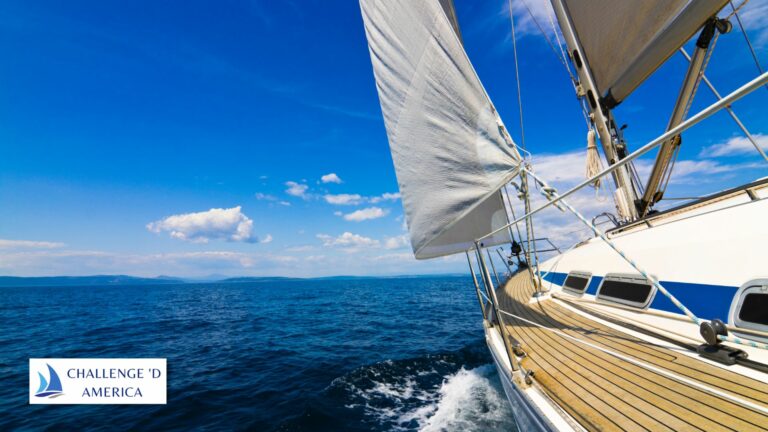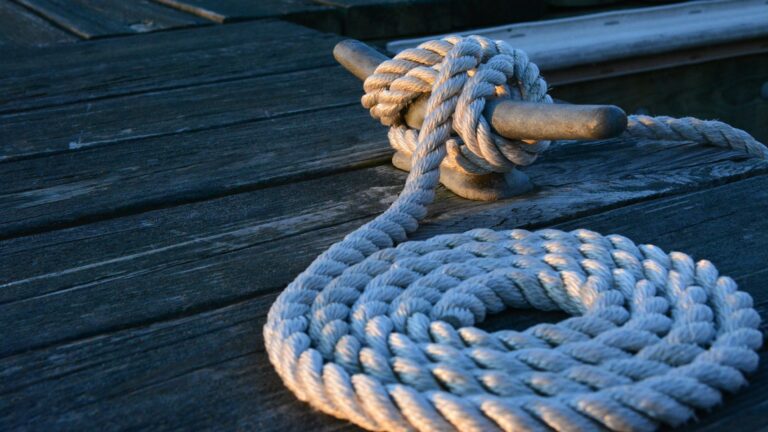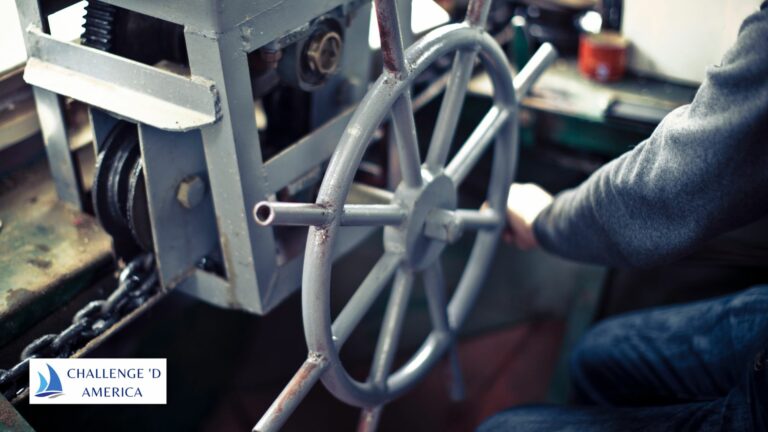All About Sails: Guide To Sail Types And Rigs
I’m excited to introduce you to my newest article on Guide to Sail Types and Rigs. In this article, I’m going to provide an in-depth look at the different types of sails and rigs you can use for sailing, no matter if you’re an experienced sailor or a novice.
I’ll explain the different materials used for sails, the different types of rigs and sails, and the advantages and disadvantages of each type. So, get ready to learn all you need to know about sails and rigs!
Parts Of Any Sail
No matter what type of sail or rig you’re dealing with, there are certain parts of any sail that are essential to its operation. Here, I’ll give a brief overview of the most common parts of any sail.
The clew is the lower corner of the sail, often where the sail is fastened to the boom. The tack is the opposite corner, located at the bow of the boat.
The luff is the leading edge of the sail, running from the tack to the head. The foot is the bottom edge of the sail, running from the clew to the head.
The head is the upper corner of the sail, which is often fastened to a mast or boom. The leech is the trailing edge of the sail, running from the clew to the tack.
Finally, the roach is the curve that lies between the luff and leech. The roach is designed to provide extra power, and often varies in shape and size depending on the sail and rig.
By understanding the parts of any sail, you can better understand how sails work and how to use them to your advantage.
Different Sail Types
When it comes to sailing, there are many different types of sails that can be used. Each sail type has its own advantages and disadvantages, and it’s important to understand the differences before selecting a sail type.
Sails are one of the most important elements when it comes to sailing, and it’s important to understand the different types of sails available and their uses.
In this sub-section, we’ll discuss the various types of sails available for a variety of purposes, from racing to cruising. We’ll look at the different materials used for sails, from traditional cotton to modern synthetic materials, and what each offers in terms of performance.
Mainsail
The mainsail is the largest and most powerful sail on a sailing vessel. It is set at the back of the boat and is responsible for pushing the boat forward.
A well-trimmed mainsail can provide the power and speed needed to complete a sailboat race or enjoy a leisurely day on the water.
Mainsails come in a variety of shapes and sizes, depending on the type of boat and the type of sailing being done. A racing boat will usually have a larger mainsail than a cruising boat.
The sail is typically constructed of high-tech fabrics, such as Dacron or Kevlar, to maximize strength and minimize weight.
The mainsail is typically controlled by two lines, called the halyard and the sheet. The halyard is used to hoist the sail, while the sheet is used to trim the sail to the wind.
To get the most performance out of the mainsail, it is important to understand the basics of sail trim and be able to adjust the sail to the conditions.
Jib
When it comes to sail types, the jib is an invaluable addition to any sailing vessel. The jib is a triangular sail that is flown from the forestay, a wire line that runs from the masthead to the bow.
It is the most efficient sail in terms of providing lift to the bow of the boat, and in combination with the mainsail, it is one of the primary ways to propel a boat forward. The jib is also used to help balance the boat and keep it from heeling too much in strong winds.
In moderate to heavy wind conditions, the jib can provide a greater percentage of the boat’s total propulsion than the mainsail, allowing the helmsman to adjust the sail trim and angle of attack to maximize performance. In addition, the jib can be adjusted quickly and easily, making it a popular sail for racing.
The jib is an essential part of any sailing vessel, and its ability to provide lift, balance, and propulsion make it an invaluable asset. With proper sail trim, the jib can help to make sailing fast and fun, and it should be in every sailor’s sail inventory.
Genoa
The Genoa sail is a popular sail type used by sailors around the world. This type of sail is typically used on larger boats and is the most efficient sail for reaching and upwind sailing.
Genoa sails have an aerodynamic shape which provides an effective balance between lift and drag. This makes them particularly useful for reaching in light to moderate winds.
Genoas come in a variety of sizes and are usually made from lightweight, durable materials such as Dacron or Kevlar. They are often fitted with a roller furling system, allowing sailors to easily adjust the size of the sail without having to drop it.
Genoa sails offer a great opportunity to maximize performance and are often used in combination with a main sail to provide extra power. They are also an excellent choice for sailing in gusty conditions, as they can be quickly adjusted to respond to changing wind conditions.
Spinnakers
Spinnakers are the iconic sail of sailing, with their large, colorful, symmetrical triangular shape. They are often seen in racing and cruising boats alike, and are a great way to add speed and power to a vessel.
Spinnakers are designed to maximize performance by taking advantage of the winds and providing lift for the boat.
Spinnakers come in a variety of sizes and shapes. They are usually made out of a lightweight, synthetic fabric that allows for quick and easy deployment. Additionally, spinnakers can be tailored to the wind conditions and type of vessel in use.

When sailing with a spinnaker, one must be careful not to over-trim the sail, as this can cause it to collapse in strong winds.
This can be dangerous, as the sail will no longer provide lift and can cause the vessel to capsize. Additionally, sailors should be aware of the amount of drag that can be caused by a spinnaker, and adjust the sail accordingly.
Spinnakers can be a lot of fun to use and can give any sailing vessel a major performance boost. With the right technique, they can be a great way to enjoy sailing and get the most out of your vessel.
Gennaker
For the more adventurous sailor, the gennaker is an excellent option for fast sailing. The gennaker, sometimes referred to as a cruising spinnaker, is a downwind sail that is typically used to sail downwind in lighter winds.
This sail is especially useful in conditions where the wind is too light for a spinnaker or a jib, as it can provide an extra boost of speed.
The gennaker is a large, asymmetrical sail that is usually flown from the bow of the boat. It has a more efficient shape than a spinnaker, so it can be flown in lighter wind conditions.
The gennaker is most effective when the wind is between 10 and 20 knots and can be used to reach speeds of up to 8 knots.
The gennaker is a powerful sail, so it requires a great deal of skill to set up and use effectively. It is not a sail for the faint of heart, but it can be an incredibly rewarding experience. If you’re looking to take your sailing to the next level, the gennaker is an excellent option.
Code Zero
Code zero sails are a specialized sail designed for light air sailing. They are designed to be used when the wind is too light for traditional sails.
They are often used in light air conditions to help the boat move faster. Code zero sails are typically very large and have an overlapping head and foot. They are often made from light-weight laminated materials and require a large mast to support them.
Code zero sails are a great way to maximize light air performance. They offer a huge boost in speed and make it possible to sail in conditions that would otherwise be too light to sail.
They also require a lot of skill and experience to use properly, so they are best left to experienced sailors. For those looking to do some light air sailing, a code zero sail might be just the ticket.
Windseeker
The Windseeker is a sailboat designed for racing and speed. It is a lightweight, high-performance sailboat that is designed to take advantage of the wind and its power. The Windseeker is a great choice for those looking to get the most out of their sailing experience.
With its lightweight construction and sleek design, it can reach speeds up to 20 knots, while still maintaining excellent maneuverability and excellent upwind performance.
Its large sail area and low drag coefficient make it an excellent choice for racing and reaching top speeds. Its lightweight construction and low drag coefficient also make it well suited for sailing in light air conditions.
With its responsive and well-balanced hull, the Windseeker is a great choice for those looking for a fast and efficient sailboat.
Drifter Reacher
For those sailors who want the best of both worlds, a drifter reacher might be the perfect solution. A drifter reacher is a type of sail that combines the characteristics of a drifter and a reacher.
This sail type is perfect for those who want to sail fast and have the ability to quickly adapt to changing conditions. With its large size, a drifter reacher provides plenty of power and control, making it a popular choice for those who want to maximize their sailing performance.
The combination of the two types of sails allows for a greater range of motion and the ability to adjust to any wind direction.
Drifter reachers are also highly efficient and require less effort to sail than other sail types, making them a great option for anyone looking to make their sailing experience more enjoyable.
Stormsail
When it comes to sailing, one of the most important considerations is the type of sails used. For extreme weather conditions, nothing is more reliable than a stormsail.
A stormsail is a specialized sail designed to be used in heavy winds and rough seas, offering the best possible protection from stormy weather.
This type of sail is typically a large, heavy-duty sail made from strong, waterproof material such as nylon or polyester. It’s designed to be deployed quickly and easily, allowing for quick and efficient maneuvering in stormy conditions.
When it comes to safety, nothing beats a stormsail. It can help prevent capsizing in extreme weather conditions, ensuring that the sailboat remains stable and safe.
It also helps protect against damage from high winds, allowing the sailboat to remain intact despite the rough conditions. For sailors intent on sailing in the roughest conditions, a stormsail is an absolute must.
Mast Configurations and Rig Types
The mast configuration and type of rig a sailboat has is an important factor to consider when selecting a boat.
There are several different mast configurations, each with its own advantages and disadvantages. Knowing which one is right for you depends on the type of sailing you plan on doing.
The most common mast configurations are sloop, cutter, ketch, yawl, and schooner. The sloop is the most popular rig today and is used for both racing and cruising.
It consists of one mast with a single headsail, usually a jib or genoa, and one mainsail. It is the simplest and most efficient rig and is suitable for most sailing conditions.
The cutter is similar to the sloop, but has two headsails and is better suited to cruising. The ketch and yawl have two masts, with the mizzenmast set further aft, and are generally used for cruising. The schooner is a more complex rig, with two or more masts, and is traditionally used for large, deep-water sailing.
Each of these rigs offers different advantages, so it’s important to know which one works best for your sailing style and the type of sailing you plan on doing.
The most important factor is to choose a rig that is suited to the type of sailing you plan on doing, and that will be comfortable and safe for you and your crew.
One-Masted Rigs
One-masted rigs are incredibly popular in sailing today, and are used for a wide range of boats, from dinghies to large yachts. It is the simplest and most efficient way to rig a boat, and can be used for both racing and cruising.
The most common type of one-masted rig is the sloop. This is the classic sailboat shape, with a single mast in the middle of the boat and two sails, the mainsail and jib. This is the most popular configuration for both racing and cruising, as it is highly efficient and easy to handle.
The ketch is another popular one-masted rig, with two masts of similar height. This is often used on cruising boats, as the two masts provide a more balanced sail plan, allowing for more sail area and stability than a single mast.
Finally, the schooner is a two-masted rig with taller masts. This is ideal for boats that require a lot of sail area, such as racing boats, as it provides a more efficient sail plan. The schooner is also popular for cruising boats, as it allows for more sail area and stability.
No matter what type of one-masted rig you choose, it is important to consider the size of the boat and the type of sailing you plan on doing, as this will determine which type of rig is best for you.
Two-Masted Rigs
Two-masted rigs have become increasingly popular in the sailing world in recent years, offering a great balance between speed, stability, and maneuverability. The two-masted rig offers a variety of advantages, with many sailors opting for this setup for long-distance cruising and racing.
The two-masted rig consists of two masts, usually set up in a sloop or cutter configuration. The two masts allow for more sail area, while the shorter masts reduce the overall weight of the boat.

This makes two-masted rigs faster and more responsive, while still being able to carry a large sail area. Two-masted rigs are also easier to tack and gybe than other rigs, as the shorter masts make it easier to maneuver.
The two-masted rig also offers greater stability in choppy seas, as the shorter masts reduce the amount of pitching and rolling. This makes two-masted rigs ideal for long-distance cruising and racing in open waters.
Overall, the two-masted rig offers a great combination of speed, stability, and maneuverability, making it a popular choice for sailors looking for a versatile and efficient rig.
Are There Different Types Of Sails?
Yes, there are a variety of different sail types and rigs available to sailors. The type of sail you use depends on the type of boat, the weather conditions, and the sailing style. The most common types of sails are triangular mainsails, headsails, jibs, and spinnakers.
Mainsails are the large triangular canvas sails that are the main source of power on a sailboat. A typical mainsail is attached to the mast and boom and has large horizontal battens to help maintain its shape.
Headsails, also known as jibs, are the sails located forward of the mast. They are usually smaller than mainsails but provide a great deal of power. Headsails are usually attached to both the mast and the bow of the boat.
Spinnakers are large, colorful sails used for downwind sailing. These sails are designed to capture the wind from any direction and provide additional power to sailboats. Spinnakers require special handling and are often used in racing sailboats.
There are many other types of sails and rigs available to sailors such as gennakers, genoas, and storm sails. No matter what type of sail you choose, it is important to understand the different types and how to use them in order to make the most out of your sailing experience.
What Are The 5 Different Kinds Of Sailing?
For sailors, understanding the different types of sails is essential to getting the most out of your sailing experience. There are five main types of sails that are used in sailing, each with its own advantages and disadvantages. Let’s take a look at them:
1. Mainsail
The mainsail is the traditional sail that is set on the mainmast of a sailing vessel. It is usually triangular in shape, and is the largest sail on a sailing vessel.
2. Genoa
The genoa is a large jib sail that is set on a roller furling system. It is typically used when sailing upwind, as it provides more power than the mainsail.
3. Spinnaker
The spinnaker is an asymmetrical sail that is used for downwind sailing. It is the most powerful sail on a sailing vessel, and provides the fastest speeds when sailing downwind.
4. Jib
The jib is a smaller sail that is set on the foremast of a sailing vessel. It is used for close-hauled sailing, and is typically the most efficient sail on a sailing vessel.
5. Gennaker
The gennaker is a large sail that is set on a furling system. It is used for downwind sailing, and is similar to the spinnaker, but with less power.
Knowing the different types of sails and their uses is essential to getting the most out of your sailing experience. Whether you are a beginner or a seasoned sailor, understanding the different types of sails and how they can be used will help you become a better sailor.
What Are The 3 Sails On A Boat Called?
When sailing on a boat with three sails, it may be helpful to understand what each sail is called. The three sails on a boat are the mainsail, the jib, and the spinnaker.
The mainsail is the large sail located at the back of the boat, and it’s the sail that catches the most wind. It’s mounted on a boom that runs along the length of the boat.
The jib is a triangular sail located near the bow of the boat, and it’s used to help steer the boat in the right direction. Finally, the spinnaker is the large, colorful sail that is used to catch the wind when the boat is sailing downwind.
Each sail has a specific purpose, and understanding the different roles of each sail can help you get the most out of your sailing experience. With a little practice, you can learn to use all three sails to your advantage.
What Is The Fastest Sailing Rig?
When it comes to the speed of a sailing rig, the answer is not so straightforward. There are many factors that go into determining a boat’s speed, such as the type and size of the sail, the construction of the hull, the shape of the keel, and the conditions of the water.
That said, some types of rigs are generally considered to be faster than others. For example, a sloop rig is often thought to be the fastest type of sailboat. This is because it has a single mast, which allows for more efficient sailing in most conditions.
Additionally, modern racing sailboats often feature the highest-tech sails and rigs, which are designed to maximize speed. This includes wingsails and fractional rigs, which have been used by some of the world’s fastest sailing vessels.
No matter what type of rig you choose, it’s important to remember that a boat’s speed is determined by many factors, and no single rig can guarantee the fastest sailing experience.
However, by carefully considering the type of rig and sails you choose, you can ensure that your boat is as fast as possible.
Conclusion On All About Sails: Guide To Sail Types And Rigs
In conclusion, sailing is an incredibly rewarding activity that offers much more than just the physical challenge of mastering the elements. It can be a great way to relax, to spend quality time with family and friends, and to enjoy the sights and sounds of nature.
With the right preparation and knowledge, sailing can be a very enjoyable and safe activity. By taking the time to learn the basics, such as the parts of a boat, knot-tying, and safety procedures, you will be well on your way to becoming a safe and confident sailor.
Thanks for Reading, and Happy Sailing!







